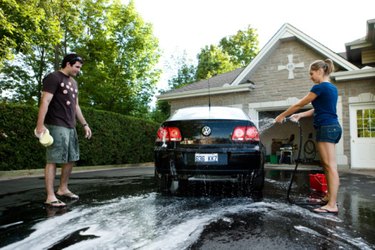
Asphalt driveways suffer through varying temperatures and weather patterns throughout the year. Couple this with the heavy car loads most driveways endure and the conditions are primed for the asphalt to crack and split under the duress. Many homeowners apply a layer of sealcoating to their driveways each year to introduce an extra barrier of protection between the asphalt and the elements. An uninterrupted drying time is crucial to the success of the sealcoat.
Step 1
Touch a spot of sealcoat at the edge of the driveway with a stick or pencil to determine if the sealcoat is still spongy, moist or tacky, which means it is still wet. On a sunny day, sealcoat can dry to the touch in as little as half an hour, but can take three hours or more in more damp conditions.
Video of the Day
Step 2
Wait five hours after the sealcoat is dry to the touch on a sunny day, then lower a shoe-covered foot onto the edge of the driveway. Remove your foot immediately if the sealcoat feels spongy or tacky. Step fully onto the driveway if your first foot does not affect the sealcoat. If the sealcoat supports your full body weight without any tackiness or play in the material, you can open the driveway up to foot traffic. Try again after a 2 to 3 hours have passed if the driveway is still tacky initially. Some sealcoats take 12 hours or more to dry enough to allow foot traffic.
Step 3
Allow the sealcoat to dry at least 24 hours before driving or parking a vehicle on it. Putting the full weight of a vehicle on sealcoating that isn't fully dry can damage the barrier.
Tip
Application of sealcoat in hot and dry weather will speed drying time over periods when it has been applied in damp and cool weather. In all cases, rather than testing the sealcoat for early access to foot traffic, you can just wait the 24 to 48 hours and open the driveway to all traffic.
Video of the Day